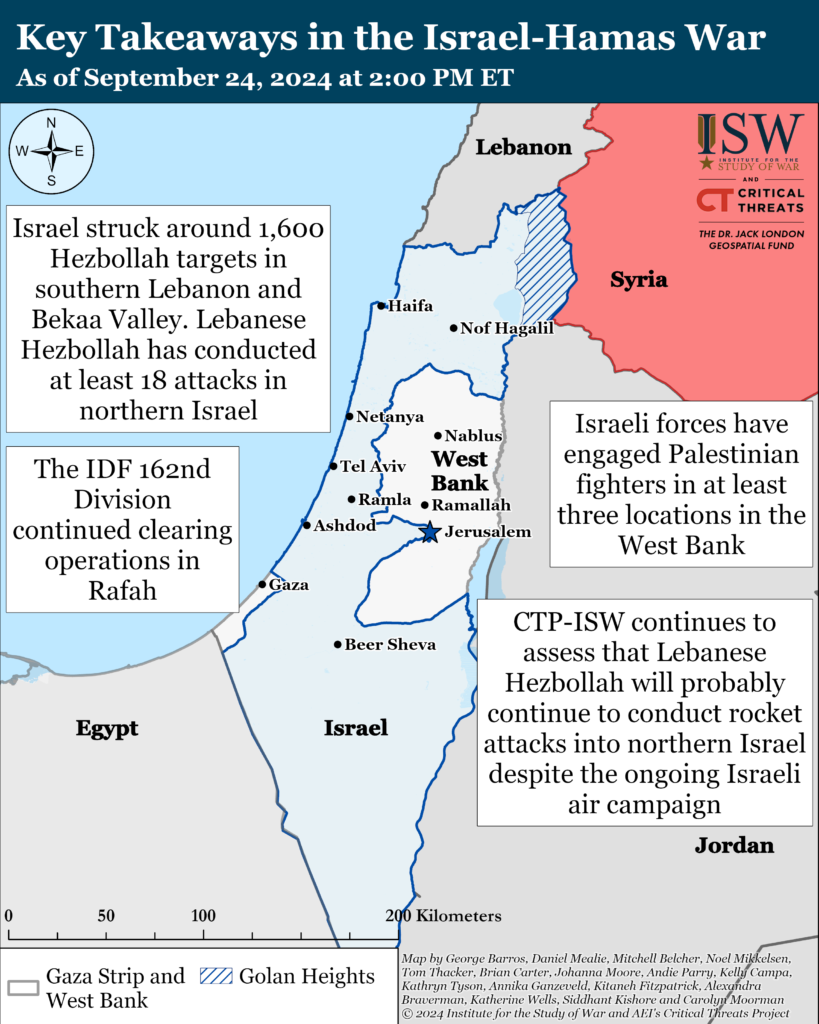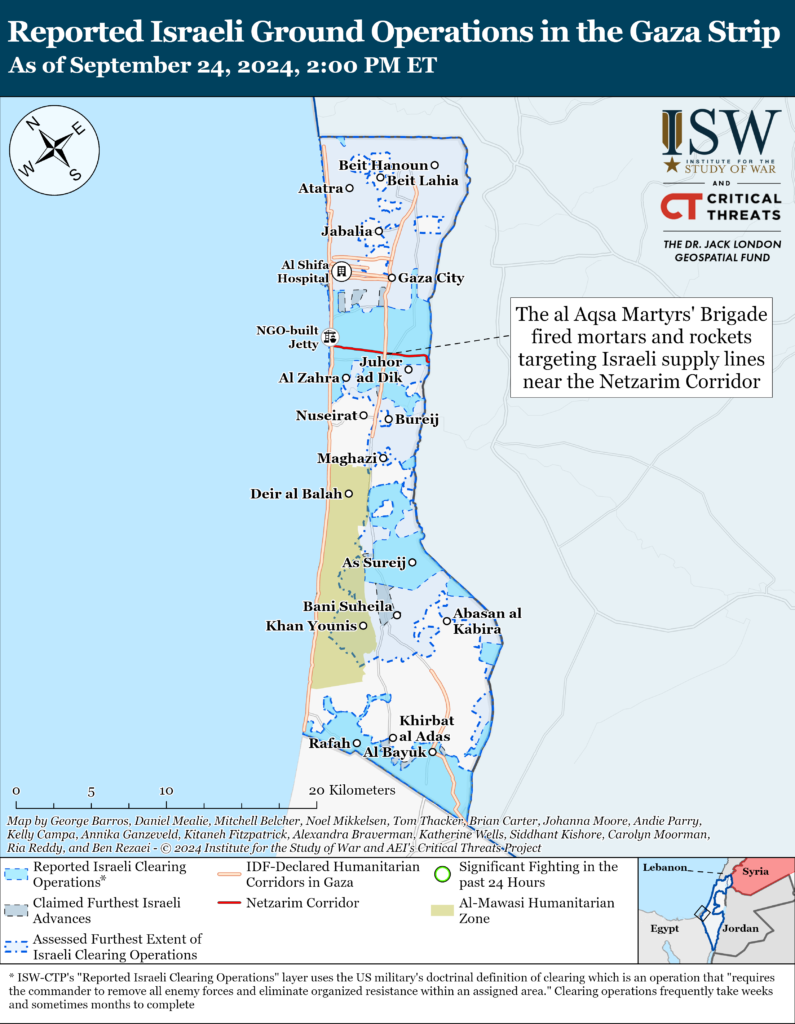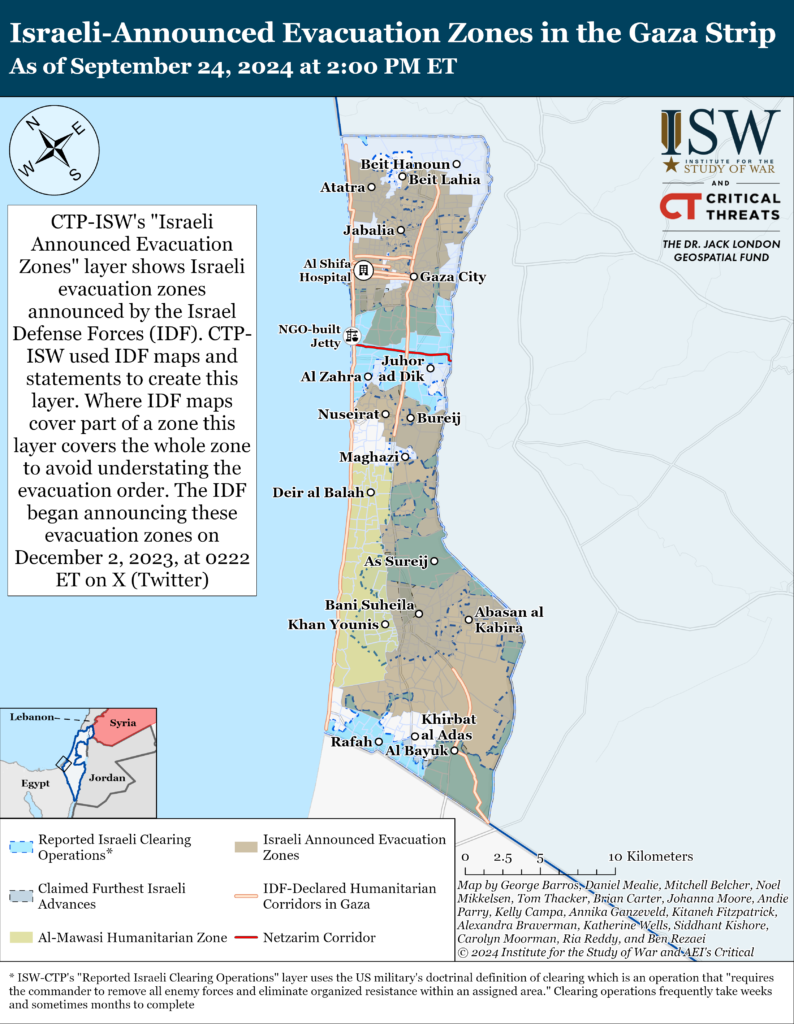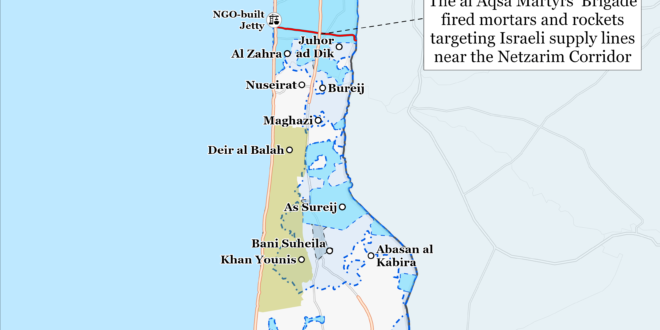The intensifying operations between Israel and Lebanese Hezbollah are part of the broader war that Israel has fought since October 7, 2023. Hezbollah has conducted almost daily attacks into Israel since the war began in order to compel Israel to accept defeat in the Gaza Strip and thus preserve Hamas.[1] Israeli Prime Minister Benjamin Netanyahu defined returning northern Israelis to their homes as an additional war aim, adding it to the objectives he set after October 7: returning Israeli hostages and destroying Hamas’ military and governance capabilities in the Gaza Strip.[2] Nasrallah has similarly directly connected Hezbollah’s war effort to the Gaza Strip in this broader conflict by tying an end to Hezbollah attacks to a ceasefire deal in the Gaza Strip.[3] Israel’s intensified air campaign in Lebanon is part of a broader Israeli strategy to defeat multiple Iranian-backed military campaigns executed by Iran and its Axis of Resistance as part of the October 7 War.
Agreeing to a ceasefire in the Gaza Strip to stop Hezbollah fire into northern Israel would not satisfy Israel’s war objectives, nor would it discourage similar Hezbollah operations in the future. Hamas’ current ceasefire demands include a ceasefire, a full Israeli withdrawal from the Gaza Strip and the release of hundreds of Palestinian prisoners, among other stipulations.[4] Hamas has set these demands in an attempt to set conditions that would enable its reconstitution in the Gaza Strip.[5] Agreeing to Hamas’ ceasefire demands would be tantamount to an Israeli defeat because Hamas’ current demands enable it to rebuild militarily and politically over time. Hamas could, if it retains access to supplies and is unbothered by Israeli military action, gradually regain some of the capabilities required to conduct future large-scale terrorist attacks into Israel. Agreeing to Hamas’ terms would also fail to ensure Israeli security over the long term because it would demonstrate to Nasrallah that Israel could be cowed and defeated by relatively inexpensive indirect fire targeting civilians in Israel. This would encourage Nasrallah to undertake similar campaigns again in the future.
CTP-ISW continues to assess that Lebanese Hezbollah will probably continue to conduct rocket attacks into northern Israel despite the ongoing Israeli air campaign, which would increase the risk of an Israeli ground campaign into Lebanon. Returning Israeli citizens to northern Israel requires that Hezbollah cease firing rockets into northern Israel. Hezbollah Secretary General Hassan Nasrallah is extremely unlikely to give the order to cease Hezbollah rocket attacks into northern Israel because he must continue to support his partners in the Axis of Resistance, as CTP-ISW has previously noted.[6]
The IDF continued its air campaign into Lebanon to degrade Hezbollah capabilities on September 23 and 24. The IDF reported on September 23 that it struck around 1,600 Hezbollah targets in southern Lebanon and the Bekaa Valley over the past day.[7] The IDF Air Force conducted at least four waves of airstrikes across Lebanon targeting rocket launchers, weapons storage facilities, and other infrastructure on September 24.[8] Israeli Army Radio reported on September 24 that the IDF has “extensively damaged” Hezbollah’s short-range rocket capabilities over the past year and started “significantly impairing” Hezbollah’s medium-range firing capabilities on September 23.[9] Israeli Army Radio noted, however, that Hezbollah still maintains long-range precision missiles in locations that the IDF has not yet targeted.[10] The IDF has expanded the range of its airstrikes into Lebanon’s northern and eastern regions in recent days.[11] Hezbollah reportedly stores its higher-value munitions, including long-range precision missiles, in these regions.[12] Targeting the relatively mobile and extremely well-hidden Hezbollah rocket, missile, and drone array is a very difficult undertaking, even for an air force as tactically proficient as the IDF Air Force.
The IDF continued to target senior Hezbollah commanders on September 24. The IDF conducted an airstrike in Dahiya neighborhood, Beirut, on September 24 that killed Hezbollah Rocket and Missile Unit Commander Ibrahim Muhammad Qabisi.[13] Qabisi commanded several Hezbollah missile units, including its precision guided missile unit.[14] Qabisi previously served in Hezbollah’s Operations unit in southern Lebanon and commanded the Badr Unit in Hezbollah’s Southern Front.[15] Israel’s targeted killing of Qabisi is part of a broader Israeli campaign to degrade senior Hezbollah leadership. The IDF conducted an airstrike in southern Beirut on September 20, killing several senior commanders in Hezbollah’s Radwan special operations forces unit including overall Radwan Commander Ibrahim Aqil.[16] The IDF also conducted an airstrike on September 23 targeting Hezbollah’s Southern Front commander, Ali Karaki.[17] An Israeli Army Radio correspondent reported on September 24 that the IDF airstrike failed to kill Karaki.[18] The correspondent added that Karaki—along with Hezbollah’s head of foreign operations unit Talal Hamia—are currently the two most senior military officials in Hezbollah.[19] CTP-ISW previously observed that Hezbollah remains a capable fighting force and that Israel’s killing of senior Hezbollah commanders will only have a temporary effect on the organization.[20]
Iran declined a request by Lebanese Hezbollah in recent days to conduct a direct attack targeting Israel, according to two unspecified Israeli officials and an unspecified Western diplomat speaking to Axios on September 24.[21] The Israeli officials stated that Iran told Hezbollah that the “timing isn’t right” for Iran to attack Israel given that Iranian President Masoud Pezeshkian is currently in New York City attending the United Nations General Assembly.[22] A separate Israeli official told Axios that the Israeli security cabinet issued a directive to the IDF to “avoid steps that would give Iran a reason or a pretext to join the fighting.”[23] It is unclear what Israeli action(s) in Lebanon would drive Iran to enter the conflict between Israel and Hezbollah directly. Iran has previously directly intervened in regional conflicts when its principal allies—such as the Bashar al Assad regime in Syria—were at risk of collapsing.[24] Iran could decide to intervene in support of Hezbollah against Israel if Iran assesses that Israel is inflicting severe damage on Hezbollah. Iran’s reluctance to directly intervene to support Hezbollah could generate tension between Hezbollah and Iran as Hezbollah seeks full Iranian support against Israel and Iran attempts to avoid a large-scale war with Israel since the beginning of the October 7 War.

This map illustrates individual Israeli air and artillery strikes based on local Lebanese reporting. This map depicts strikes reported from 2:00pm ET on September 23 to 2:00pm ET on September 24. This map is not exhaustive. CTP-ISW cannot independently verify the locations of Israeli strikes.
Lebanese Hezbollah continued its expanded attack campaign against Israel by targeting several new Israeli civilian and military sites on September 23 and 24. Hezbollah launched medium-range rockets targeting IDF Ramat David airbase in northern Israel for the third consecutive day.[25] Hezbollah also conducted a three-wave rocket attack targeting an IDF airfield in Jezreel Valley, which is an auxiliary airfield for Ramat David airbase.[26] The IDF said that it detected several projectiles over Jezreel valley and intercepted some of them, while the remaining fell in open areas in the valley.[27] Hezbollah also claimed that it launched one-way attack drones targeting an IDF naval base in Atlit, south of Haifa, for the first time.[28] The Atlit naval base is the headquarters of the IDF’s elite marine commando unit Shayetet 13.[29] Hezbollah also launched rockets explicitly targeting three new civilian and military sites in Israel and the Golan Heights for the first time since launching its indirect fire campaign targeting northern Israel on October 8, 2023.[30] Lebanese Hezbollah claimed on September 23 that the expanded attack campaign against Israel is in ”defense of Lebanon and its people.”[31]
Key Takeaways:
Lebanon: The intensifying operations between Israel and Lebanese Hezbollah are part of the broader war that Israel has fought since October 7, 2023. Hezbollah has conducted almost daily attacks into Israel since the war began in order to compel Israel to accept defeat in the Gaza Strip and thus preserve Hamas. Agreeing to a ceasefire in the Gaza Strip to stop Hezbollah fire into northern Israel would not satisfy Israel’s war objectives, nor would it discourage similar Hezbollah operations in the future.
Israeli Air Campaign in Lebanon: The IDF continued its air campaign into Lebanon to degrade Hezbollah capabilities on September 23 and 24. The IDF reported on September 23 that it struck around 1,600 Hezbollah targets in southern Lebanon and the Bekaa Valley over the past day.
Iranian Response to Israeli Operations in Lebanon: Iran declined a request by Lebanese Hezbollah in recent days to conduct a direct attack targeting Israel, according to two unspecified Israeli officials and an unspecified Western diplomat speaking to Axios on September 24.
Hezbollah Attack Campaign in Israel: Lebanese Hezbollah continued its expanded attack campaign against Israel by targeting several new Israeli civilian and military sites on September 23 and 24.

Gaza Strip
Axis of Resistance objectives:
Erode the will of the Israeli political establishment and public to sustain clearing operations in the Gaza Strip
Reestablish Hamas as the governing authority in the Gaza Strip
The IDF 162nd Division continued clearing operations in Rafah on September 23.[32] The Nahal Brigade located weapons and killed a Palestinian fighter armed with a rocket-propelled grenade (RPG).[33]
The al Aqsa Martyrs’ Brigade fired mortars and rockets targeting Israeli supply lines near the Netzarim Corridor on September 23.[34] Al Aqsa Martyrs’ Brigade has conducted multiple attacks targeting Israeli forces near the Netzarim Corridor recently.[35]


West Bank
Axis of Resistance objectives:
Establish the West Bank as a viable front against Israel
Israeli forces have engaged Palestinian fighters in at least three locations in the West Bank since CTP-ISW’s last data cutoff on September 23.[36] The al Aqsa Martyrs’ Brigades and the Palestinian Islamic Jihad (PIJ) fired small arms and detonated IEDs targeting Israeli forces in Yamun, Jenin Governorate.[37] The al Aqsa Martyrs’ Brigades separately clashed with the IDF in Tammun, Tubas Governorate, on September 24.[38]

This map is not an exhaustive depiction of clashes and demonstrations in the West Bank.
Southern Lebanon and Golan Heights
Axis of Resistance objectives:
Deter Israel from conducting a ground operation into Lebanon
Prepare for an expanded and protracted conflict with Israel in the near term
Expel the United States from Syria
Lebanese Hezbollah has conducted at least 18 attacks into northern Israel since CTP-ISW’s last data cutoff on September 23.[39] See topline section.
Palestinian Islamic Jihad (PIJ) announced the death of two PIJ fighters in southern Lebanon on September 23.[40] The fighters were a part of PIJ’s Syrian-based Martyr Ali al Aswad Brigade. CTP-ISW previously reported that Hezbollah has used Palestinian fighters, including from PIJ, to attack Israel from Lebanon under Iranian direction.[41] IDF strikes have killed multiple PIJ fighters in southern Lebanon throughout the war.[42]
Iran and the Axis of Resistance
The Islamic Resistance in Iraq—a coalition of Iranian-backed Iraqi militias—claimed an Arfad drone attack targeting an unspecified location in the Golan Heights on September 23.[43]
Islamic Revolutionary Guards Corps (IRGC) Quds Force Commander Brigadier General Esmail Ghaani reportedly traveled to Baghdad on September 17 to reduce political infighting in the Iraqi government following allegations that senior officials in the Iraqi Prime Minister’s Office conducted a surveillance campaign targeting numerous senior Iraqi government officials and politicians.[44] Ghaani reportedly told Shia Coordination Framework leaders not to undermine Iraqi Prime Minister Mohammad Shia al Sudani and emphasized that stability in Iraq is critical amid rising tensions in the region during his recent visit to Baghdad, according to seven unspecified Iraqi sources.[45] The Iraqi government arrested several senior officials in Sudani’s office in August 2024 for participating in the surveillance campaign, which began in late 2023.[46] The campaign targeted Supreme Judicial Council President Faiq Zaidan and several Iranian-backed Shia Coordination Framework leaders, including former Iraqi Prime Minister Nouri al Maliki.[47]
Iranian Supreme Leader Ali Khamenei appointed Mohammad Mokhber as his adviser on September 24. Khamenei emphasized that Iran would continue policies initiated under former Iranian President Ebrahim Raisi’s administration.[48] Mokhber was the interim president of Iran for 50 days following Raisi‘s death.[49] Mokhber played a key role in Iran’s COVID-19 response as head of the Execution of Imam Khomeini’s Order (EIKO)[50] which is a powerful economic conglomerate controlled by Khamenei, managing vast assets across various sectors, including real estate, finance, and healthcare.[51]
Iranian President Masoud Pezeshkian met with international leaders on the sidelines of the United Nations General Assembly (UNGA) in New York on September 23 and 24.[52] Pezeshkian discussed ongoing conflicts in the Middle East and Iran’s diplomatic relations with other Persian Gulf countries in the Middle East with United Nations Secretary-General Antonio Guterres.[53] Pezeshkian denied that Iran sent ballistic missiles to Russia during his meeting with European Council President Charles Michel.[54] Pezeshkian told the Turkish and Finnish presidents in separate meetings that Iran sought deeper ties with both countries.[55] Pezeshkian also spoke to Tajik President Emomali Rahmon about further cooperation, particularly on security issues in Afghanistan.[56]
Iranian Communications and Information Technology Minister Sattar Hashemi and Cuban Communications Minister Mayra Arevich Marin discussed cooperation in the field of communications and technology on September 24.[57] Marin invited Hashemi to the 40th Havana Exhibition from November 4 to 9, and the 19th Joint Economic Cooperation Commission meeting between Iran and Cuba.[58]
Iranian foreign affairs ministry officials met with western officials on the sidelines of the UN General Assembly in New York on September 24 to discuss nuclear issues.[59] Iranian Foreign Affairs Minister Abbas Araghchi “met and reestablish[ed] contact” with International Atomic Energy Agency Director General Rafael Grossi.[60] Grossi reiterated that he will visit Tehran soon to continue discussions on nuclear issues.[61] Deputy Foreign Affairs Minister Majid Takht Ravanchi stated that he discussed “issues related to lifting sanctions and nuclear matters” during his meeting with EU Deputy Secretary General Enrique Mora.[62] Ravanchi emphasized that Iran is willing to “address mutual concerns and interests through diplomacy.” The Masoud Pezeshkian administration is continuing to signal its willingness to pursue nuclear negotiations with the West.[63]
 Eurasia Press & News
Eurasia Press & News


